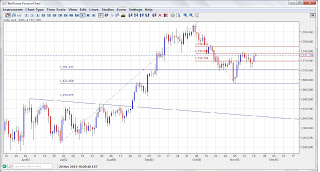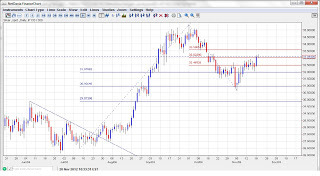

| Visitors Now: | |
| Total Visits: | |
| Total Stories: |

| Story Views | |
| Now: | |
| Last Hour: | |
| Last 24 Hours: | |
| Total: | |
Gold and Silver At A Crossroads, But Solid Fundamentals Support A Move To New All-time Highs In 2013
No market moves straight up, or straight down. Corrections should be welcomed, and looked at as opportunities to add to positions in the direction you believe the market is moving within the “big picture”.
The “correction zone” for any strong rally is between 38% and 50% of the rally [or decline]. If a market finds support within the correction zone, it is likely to soon retest its recent high, and/or extend the recent rally to new highs [or lows].
Understanding this technical aspect of any market makes it much easier to understand and take advantage of “opportunities” a market presents to ALL traders.
With that being said, please note that since I suggested “buying the dip” in my November 2nd post, both Gold and Silver have rallied and regained 50% of their respective October declines.
Gold and Silver are at a crossroads now. Take out the respective 50% Fibonacci retracements of their October declines, and we can expect to see a retest of the late September highs in both Precious Metals going into the Christmas holidays.
Foreign Buying of U.S. Assets Plunges on Europe Optimism
By Kasia Klimasinska and Meera Louis – Nov 16, 2012 11:53 AM ET
International purchases of U.S. financial assets plunged 96 percent in September as confidence grew that Europe was beginning to solve its debt crisis and investors sold Treasuries following the Federal Reserve’s quantitative easing announcement.
Net buying of long-term equities, notes and bonds totaled $3.3 billion during the month, down from net purchases of $90.3 billion in August, the Treasury Department said today in Washington. Economists surveyed by Bloomberg projected net buying of $50 billion of long-term assets, according to the median estimate.
ECB President Mario Draghi has called the euro “irreversible” and said the new government bond purchasing program will have effective conditionality attached. Photographer: Andrew Harrer/Bloomberg
The Federal Open Market Committee said Sept. 13 that it would undertake a third round of quantitative easing by purchasing mortgage-backed securities at a pace of $40 billion per month until labor markets improve substantially.
“QE3 certainly played its role in basically encouraging people to take risk and to some extent to short the dollar,” Sebastien Galy, a senior foreign-exchange strategist at Societe Generale SA in New York, said. “The risk appetite was pretty strong overall, there were better places to park your money than the dollar,” and “there was a big rise in optimism regarding the euro zone.”
Asian economies turn to yuan
Updated: 2012-10-24 00:57
By Gao Changxin ( China Daily)
A “renminbi bloc” has been formed in East Asia, as nations in the region abandon the US dollar and peg their currency to the Chinese yuan — a major signal of China’s successful bid to internationalize its currency, a research report has said.
The Peterson Institute for International Economics, or PIIE, said in its latest research that China has moved closer to its long-term goal for the renminbi to become a global reserve currency.
Since the global financial crisis, the report said, more and more nations, especially emerging economies, see the yuan as the main reference currency when setting their exchange rate.
And now seven out of 10 economies in the region — including South Korea, Indonesia, Malaysia, Singapore and Thailand — track the renminbi more closely than they do the US dollar. Only three economies in the group — Hong Kong, Vietnam, and Mongolia — still have currencies following the dollar more closely than the renminbi, said the report, posted on the institute’s website.
The South Korean won, for example, has appreciated in sync with the renminbi against the dollar since mid-2010.
China has long vowed to raise its currency’s global sway, along with the rise of its economy, which became the world’s second-biggest last year.
U.S. Companies Cut Spending Plans Amid Fiscal and Economic Uncertainty
By SUDEEP REDDY and SCOTT THURM
U.S. companies are scaling back investment plans at the fastest pace since the recession, signaling more trouble for the economic recovery.
Half of the nation’s 40 biggest publicly traded corporate spenders have announced plans to curtail capital expenditures this year or next, according to a review by The Wall Street Journal of securities filings and conference calls.
Nationwide, business investment in equipment and software—a measure of economic vitality in the corporate sector—stalled in the third quarter for the first time since early 2009. Corporate investment in new buildings has declined.
At the same time, exports are slowing or falling to such critical markets as China and the euro zone as the global economy downshifts, creating another drag on firms’ expansion plans.
Corporate executives say they are slowing or delaying big projects to protect profits amid easing demand and rising uncertainty. Uncertainty around the U.S. elections and federal budget policies also appear among the factors driving the investment pullback since midyear. It is unclear whether Washington will avert the so-called fiscal cliff, tax increases and spending cuts scheduled to begin Jan. 2.
Treasury Secretary Geithner: Lift Debt Limit to Infinity
(CNSNews.com) – Treasury Secretary Timothy Geithner said Friday that Congress should stop placing legal limits on the amount of money the government can borrow and effectively lift the debt limit to infinity.
On Bloomberg TV, “Political Capital” host Al Hunt asked Geithner if he believes “we ought to just eliminate the debt ceiling.”
“Oh, absolutely,” Geithner said.
“You do? Will you propose that?” Hunt asked.
Money manager Eric Sprott says, “The central banks’ gold is likely gone with no realistic chance of getting it back.” Don’t expect this revelation to get any coverage by the mainstream media. In an interview last week, Sprott’s analysis was met with words such as “gold bug” and “conspiracy theory.” Sprott answers that sort of disrespect by saying, “We’ve had so many conspiracies, I don’t know why anyone would think this was unusual.” To back up his point, he named “LIBOR, electricity markets in California and the Madoff” scandals. Sprott’s analysis shows a “flat supply” and at least a “2,500 ton net increase in gold demand” since 2000. “Where’s all the gold coming from?” asks Sprott. He says Western central banks “. . . keep supplying this market with product in order to keep the price down so nobody knows how vulnerable the situation is.” Sprott, who manages nearly $10 billion in assets, boldly proclaims, “We have a shortage of gold.” Join Greg Hunter as he goes One-on-One with Eric Sprott of Sprott Asset Management.
___________________________________
Jeff Clark: So How Many Ounces of Gold (or Silver) Should You Own?
For me, I am probably going to use some of this gold if we get high inflation. How are you going to protect your standard of living if we get some kind of runaway inflation? And let’s say it’s not runaway hyperinflation; let’s just say it’s high inflation, 10%, 15%. Remember it was 14% in 1980, so the odds of us getting high inflation are realistic. So if I am going to use that gold to cover my standard of living, you are going to need about two thirds of an ounce of gold for every thousand dollars of monthly expenses. If you want to protect your standard of living and not have your house be ravaged by inflation, so to speak, so that is a good guideline to follow.
So if inflation lasts a couple years, well, you are going to need 15 ounces of gold for every thousand dollars of monthly expenses. That is a good guideline to think about. And if your expenses are more per month, you are going to need more gold than that. If inflation lasts longer than two years, you are going to need more than that, but you can actually use the sales of gold and silver to protect your standard of living. You sell some gold and silver, you are going to get U.S. dollars or Canadian dollars with it and you can use the increase in the gold and silver price to offset the increase in the goods and services you are buying.
So I think that is the way to view it, to look at how you are going to use it. And so the focus again comes back to how many ounces do you own? So if you do not have any, you need to obviously start buying.
2012-11-20 15:24:43
Source: http://goldharvest.blogspot.com/2012/11/gold-and-silver-at-crossroads-but-solid.html
Source:




